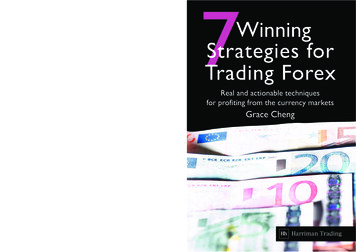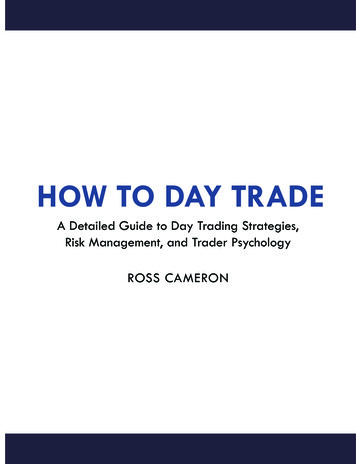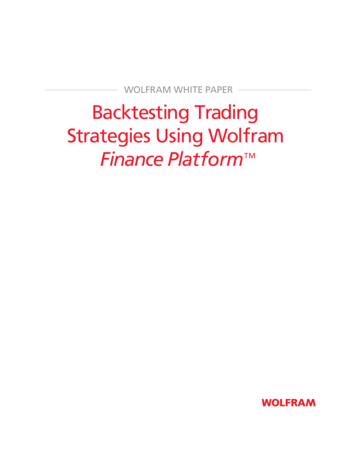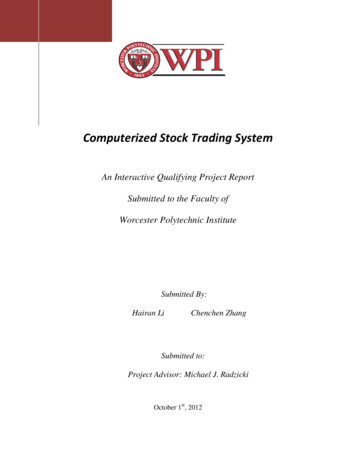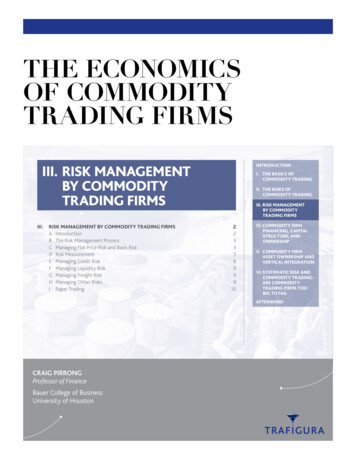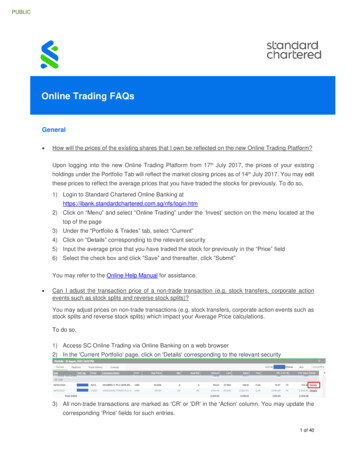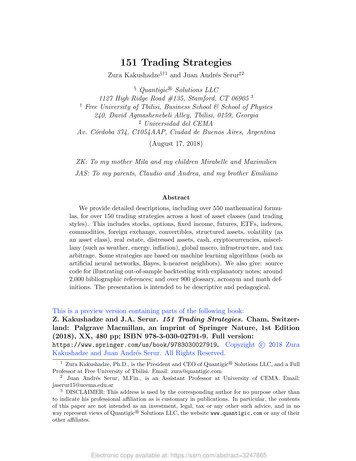
Transcription
151 Trading StrategiesZura Kakushadze§†1 and Juan Andrés Serur 2Quantigicr Solutions LLC1127 High Ridge Road #135, Stamford, CT 06905 3†Free University of Tbilisi, Business School & School of Physics240, David Agmashenebeli Alley, Tbilisi, 0159, Georgia Universidad del CEMAAv. Córdoba 374, C1054AAP, Ciudad de Buenos Aires, Argentina§(August 17, 2018)ZK: To my mother Mila and my children Mirabelle and MaximilienJAS: To my parents, Claudio and Andrea, and my brother EmilianoAbstractWe provide detailed descriptions, including over 550 mathematical formulas, for over 150 trading strategies across a host of asset classes (and tradingstyles). This includes stocks, options, fixed income, futures, ETFs, indexes,commodities, foreign exchange, convertibles, structured assets, volatility (asan asset class), real estate, distressed assets, cash, cryptocurrencies, miscellany (such as weather, energy, inflation), global macro, infrastructure, and taxarbitrage. Some strategies are based on machine learning algorithms (such asartificial neural networks, Bayes, k-nearest neighbors). We also give: sourcecode for illustrating out-of-sample backtesting with explanatory notes; around2,000 bibliographic references; and over 900 glossary, acronym and math definitions. The presentation is intended to be descriptive and pedagogical.This is a preview version containing parts of the following book:Z. Kakushadze and J.A. Serur. 151 Trading Strategies. Cham, Switzerland: Palgrave Macmillan, an imprint of Springer Nature, 1st Edition(2018), XX, 480 pp; ISBN 978-3-030-02791-9. Full 7919. Copyright c 2018 ZuraKakushadze and Juan Andrés Serur. All Rights Reserved.Zura Kakushadze, Ph.D., is the President and CEO of Quantigicr Solutions LLC, and a FullProfessor at Free University of Tbilisi. Email: zura@quantigic.com2Juan Andrés Serur, M.Fin., is an Assistant Professor at University of CEMA. Email:jaserur15@ucema.edu.ar3DISCLAIMER: This address is used by the corresponding author for no purpose other thanto indicate his professional affiliation as is customary in publications. In particular, the contentsof this paper are not intended as an investment, legal, tax or any other such advice, and in noway represent views of Quantigicr Solutions LLC, the website www.quantigic.com or any of theirother affiliates.1Electronic copy available at: https://ssrn.com/abstract 3247865
This is a preview version containing parts of the following book:Z. Kakushadze and J.A. Serur. 151 Trading Strategies. Cham, Switzerland:Palgrave Macmillan, an imprint of Springer Nature, 1st Edition (2018), XX,480 pp; ISBN 978-3-030-02791-9. Full 7919. Copyright c 2018Zura Kakushadze and Juan Andrés Serur. All Rights Reserved.ContentsPraises of 151 Trading Strategies71 Introduction and Summary92 Options2.1 Generalities . . . . . . . . . . . . . . .2.2 Strategy: Covered call . . . . . . . . .2.3 Strategy: Covered put . . . . . . . . .2.4 Strategy: Protective put . . . . . . . .2.5 Strategy: Protective call . . . . . . . .2.6 Strategy: Bull call spread . . . . . . .2.7 Strategy: Bull put spread . . . . . . .2.8 Strategy: Bear call spread . . . . . . .2.9 Strategy: Bear put spread . . . . . . .2.10 Strategy: Long synthetic forward . . .2.11 Strategy: Short synthetic forward . . .2.12 Strategy: Long combo . . . . . . . . .2.13 Strategy: Short combo . . . . . . . . .2.14 Strategy: Bull call ladder . . . . . . . .2.15 Strategy: Bull put ladder . . . . . . . .2.16 Strategy: Bear call ladder . . . . . . .2.17 Strategy: Bear put ladder . . . . . . .2.18 Strategy: Calendar call spread . . . . .2.19 Strategy: Calendar put spread . . . . .2.20 Strategy: Diagonal call spread . . . . .2.21 Strategy: Diagonal put spread . . . . .2.22 Strategy: Long straddle . . . . . . . .2.23 Strategy: Long strangle . . . . . . . . .2.24 Strategy: Long guts . . . . . . . . . . .2.25 Strategy: Short straddle . . . . . . . .2.26 Strategy: Short strangle . . . . . . . .2.27 Strategy: Short guts . . . . . . . . . .2.28 Strategy: Long call synthetic straddle .2.29 Strategy: Long put synthetic straddle .2.30 Strategy: Short call synthetic straddle2.31 Strategy: Short put synthetic straddle2.32 Strategy: Covered short straddle . . .2.33 Strategy: Covered short strangle . . . .2.34 Strategy: Strap . . . . . . . . . . . . .2.35 Strategy: Strip . . . . . . . . . . . . .2.36 Strategy: Call ratio backspread . . . .1Electronic copy available at: https://ssrn.com/abstract 19202020212121222222232323242424
This is a preview version containing parts of the following book:Z. Kakushadze and J.A. Serur. 151 Trading Strategies. Cham, Switzerland:Palgrave Macmillan, an imprint of Springer Nature, 1st Edition (2018), XX,480 pp; ISBN 978-3-030-02791-9. Full 7919. Copyright c 2018Zura Kakushadze and Juan Andrés Serur. All Rights 29292930303131313232333 Stocks3.1 Strategy: Price-momentum . . . . . . . . . . . . . .3.2 Strategy: Earnings-momentum . . . . . . . . . . . .3.3 Strategy: Value . . . . . . . . . . . . . . . . . . . .3.4 Strategy: Low-volatility anomaly . . . . . . . . . .3.5 Strategy: Implied volatility . . . . . . . . . . . . . .3.6 Strategy: Multifactor portfolio . . . . . . . . . . . .3.7 Strategy: Residual momentum . . . . . . . . . . . .3.8 Strategy: Pairs trading . . . . . . . . . . . . . . . .3.9 Strategy: Mean-reversion – single cluster . . . . . .3.9.1 Strategy: Mean-reversion – multiple clusters3.10 Mean-reversion – weighted regression . . . . . . . .3.11 Strategy: Single moving average . . . . . . . . . . .3.12 Strategy: Two moving averages . . . . . . . . . . .3.13 Strategy: Three moving averages . . . . . . . . . .3.14 Strategy: Support and resistance . . . . . . . . . .3.15 Strategy: Channel . . . . . . . . . . . . . . . . . .3.16 Strategy: Event-driven – M&A . . . . . . . . . . .3.17 Strategy: Machine learning – single-stock KNN . .562.57Strategy: Put ratio backspread . . . .Strategy: Ratio call spread . . . . . . .Strategy: Ratio put spread . . . . . . .Strategy: Long call butterfly . . . . . .2.40.1 Strategy: Modified call butterflyStrategy: Long put butterfly . . . . . .2.41.1 Strategy: Modified put butterflyStrategy: Short call butterfly . . . . .Strategy: Short put butterfly . . . . .Strategy: “Long” iron butterfly . . . .Strategy: “Short” iron butterfly . . . .Strategy: Long call condor . . . . . . .Strategy: Long put condor . . . . . . .Strategy: Short call condor . . . . . . .Strategy: Short put condor . . . . . . .Strategy: Long iron condor . . . . . . .Strategy: Short iron condor . . . . . .Strategy: Long box . . . . . . . . . . .Strategy: Collar . . . . . . . . . . . . .Strategy: Bullish short seagull spread .Strategy: Bearish long seagull spread .Strategy: Bearish short seagull spreadStrategy: Bullish long seagull spread .2Electronic copy available at: https://ssrn.com/abstract 3247865
This is a preview version containing parts of the following book:Z. Kakushadze and J.A. Serur. 151 Trading Strategies. Cham, Switzerland:Palgrave Macmillan, an imprint of Springer Nature, 1st Edition (2018), XX,480 pp; ISBN 978-3-030-02791-9. Full 7919. Copyright c 2018Zura Kakushadze and Juan Andrés Serur. All Rights Reserved.3.18 Strategy: Statistical arbitrage – optimization3.18.1 Dollar-neutrality . . . . . . . . . . .3.19 Strategy: Market-making . . . . . . . . . . .3.20 Strategy: Alpha combos . . . . . . . . . . .3.21 A few comments . . . . . . . . . . . . . . .4 Exchange-traded funds (ETFs)4.1 Strategy: Sector momentum rotation . . . . . . . . .4.1.1 Strategy: Sector momentum rotation with MA4.1.2 Strategy: Dual-momentum sector rotation . .4.2 Strategy: Alpha rotation . . . . . . . . . . . . . . . .4.3 Strategy: R-squared . . . . . . . . . . . . . . . . . .4.4 Strategy: Mean-reversion . . . . . . . . . . . . . . . .4.5 Strategy: Leveraged ETFs (LETFs) . . . . . . . . . .4.6 Strategy: Multi-asset trend following . . . . . . . . .5 Fixed Income5.1 Generalities . . . . . . . . . . . . . . . . . . . . . . .5.1.1 Zero-coupon bonds . . . . . . . . . . . . . . .5.1.2 Bonds with coupons . . . . . . . . . . . . . .5.1.3 Floating rate bonds . . . . . . . . . . . . . . .5.1.4 Swaps . . . . . . . . . . . . . . . . . . . . . .5.1.5 Duration and convexity . . . . . . . . . . . . .5.2 Strategy: Bullets . . . . . . . . . . . . . . . . . . . .5.3 Strategy: Barbells . . . . . . . . . . . . . . . . . . . .5.4 Strategy: Ladders . . . . . . . . . . . . . . . . . . . .5.5 Strategy: Bond immunization . . . . . . . . . . . . .5.6 Strategy: Dollar-duration-neutral butterfly . . . . . .5.7 Strategy: Fifty-fifty butterfly . . . . . . . . . . . . .5.8 Strategy: Regression-weighted butterfly . . . . . . . .5.8.1 Strategy: Maturity-weighted butterfly . . . . .5.9 Strategy: Low-risk factor . . . . . . . . . . . . . . . .5.10 Strategy: Value factor . . . . . . . . . . . . . . . . .5.11 Strategy: Carry factor . . . . . . . . . . . . . . . . .5.12 Strategy: Rolling down the yield curve . . . . . . . .5.13 Strategy: Yield curve spread (flatteners & steepeners)5.14 Strategy: CDS basis arbitrage . . . . . . . . . . . . .5.15 Strategy: Swap-spread arbitrage . . . . . . . . . . . .4950525354. . .filter. . . . . . . . . . . . 67676868696970.6 Indexes706.1 Generalities . . . . . . . . . . . . . . . . . . . . . . . . . . . . . . . . 706.2 Strategy: Cash-and-carry arbitrage . . . . . . . . . . . . . . . . . . . 716.3 Strategy: Dispersion trading in equity indexes . . . . . . . . . . . . . 713Electronic copy available at: https://ssrn.com/abstract 3247865
This is a preview version containing parts of the following book:Z. Kakushadze and J.A. Serur. 151 Trading Strategies. Cham, Switzerland:Palgrave Macmillan, an imprint of Springer Nature, 1st Edition (2018), XX,480 pp; ISBN 978-3-030-02791-9. Full 7919. Copyright c 2018Zura Kakushadze and Juan Andrés Serur. All Rights Reserved.6.46.56.3.1 Strategy: Dispersion trading – subset portfolio . . . . . . . . . 72Strategy: Intraday arbitrage between index ETFs . . . . . . . . . . . 73Strategy: Index volatility targeting with risk-free asset . . . . . . . . 747 Volatility7.1 Generalities . . . . . . . . . . . . . . . . . . . . . . . . . . . .7.2 Strategy: VIX futures basis trading . . . . . . . . . . . . . . .7.3 Strategy: Volatility carry with two ETNs . . . . . . . . . . . .7.3.1 Strategy: Hedging short VXX with VIX futures . . . .7.4 Strategy: Volatility risk premium . . . . . . . . . . . . . . . .7.4.1 Strategy: Volatility risk premium with Gamma hedging7.5 Strategy: Volatility skew – long risk reversal . . . . . . . . . .7.6 Strategy: Volatility trading with variance swaps . . . . . . . .8 Foreign Exchange (FX)8.1 Strategy: Moving averages with HP filter8.2 Strategy: Carry trade . . . . . . . . . . .8.2.1 Strategy: High-minus-low carry .8.3 Strategy: Dollar carry trade . . . . . . .8.4 Strategy: Momentum & carry combo . .8.5 Strategy: FX triangular arbitrage . . . .9 Commodities9.1 Strategy: Roll yields . . . . . . . . . . . . . . . . .9.2 Strategy: Trading based on hedging pressure . . . .9.3 Strategy: Portfolio diversification with commodities9.4 Strategy: Value . . . . . . . . . . . . . . . . . . . .9.5 Strategy: Skewness premium . . . . . . . . . . . . .9.6 Strategy: Trading with pricing models . . . . . . .10 Futures10.1 Strategy: Hedging risk with futures . . . . . . . . . .10.1.1 Strategy: Cross-hedging . . . . . . . . . . . .10.1.2 Strategy: Interest rate risk hedging . . . . . .10.2 Strategy: Calendar spread . . . . . . . . . . . . . . .10.3 Strategy: Contrarian trading (mean-reversion) . . . .10.3.1 Strategy: Contrarian trading – market activity10.4 Strategy: Trend following (momentum) . . . . . . . .11 Structured Assets11.1 Generalities: Collateralized Debt Obligations (CDOs)11.2 Strategy: Carry, equity tranche – index hedging . . .11.3 Strategy: Carry, senior/mezzanine – index hedging .11.4 Strategy: Carry – tranche hedging . . . . . . . . . . .4Electronic copy available at: https://ssrn.com/abstract 848585.8686878788898990.9191939393
This is a preview version containing parts of the following book:Z. Kakushadze and J.A. Serur. 151 Trading Strategies. Cham, Switzerland:Palgrave Macmillan, an imprint of Springer Nature, 1st Edition (2018), XX,480 pp; ISBN 978-3-030-02791-9. Full 7919. Copyright c 2018Zura Kakushadze and Juan Andrés Serur. All Rights Reserved.11.5 Strategy: Carry – CDS hedging . . . . . . . . . . . . . . . . . . . . . 9411.6 Strategy: CDOs – curve trades . . . . . . . . . . . . . . . . . . . . . 9411.7 Strategy: Mortgage-backed security (MBS) trading . . . . . . . . . . 9412 Convertibles9512.1 Strategy: Convertible arbitrage . . . . . . . . . . . . . . . . . . . . . 9512.2 Strategy: Convertible option-adjusted spread . . . . . . . . . . . . . . 9613 Tax Arbitrage9613.1 Strategy: Municipal bond tax arbitrage . . . . . . . . . . . . . . . . . 9613.2 Strategy: Cross-border tax arbitrage . . . . . . . . . . . . . . . . . . 9713.2.1 Strategy: Cross-border tax arbitrage with options . . . . . . . 9814 Miscellaneous Assets14.1 Strategy: Inflation hedging – inflation swaps14.2 Strategy: TIPS-Treasury arbitrage . . . . .14.3 Strategy: Weather risk – demand hedging .14.4 Strategy: Energy – spark spread . . . . . . .98989910010215 Distressed Assets15.1 Strategy: Buying and holding distressed debt . . . . . .15.2 Strategy: Active distressed investing . . . . . . . . . . .15.2.1 Strategy: Planning a reorganization . . . . . . . .15.2.2 Strategy: Buying outstanding debt . . . . . . . .15.2.3 Strategy: Loan-to-own . . . . . . . . . . . . . . .15.3 Strategy: Distress risk puzzle . . . . . . . . . . . . . . .15.3.1 Strategy: Distress risk puzzle – risk management.102102103103103104104104.16 Real Estate16.1 Generalities . . . . . . . . . . . . . . . . . . . . . . . . . . . .16.2 Strategy: Mixed-asset diversification with real estate . . . . .16.3 Strategy: Intra-asset diversification within real estate . . . . .16.3.1 Strategy: Property type diversification . . . . . . . . .16.3.2 Strategy: Economic diversification . . . . . . . . . . . .16.3.3 Strategy: Property type and geographic diversification16.4 Strategy: Real estate momentum – regional approach . . . . .16.5 Strategy: Inflation hedging with real estate . . . . . . . . . . .16.6 Strategy: Fix-and-flip . . . . . . . . . . . . . . . . . . . . . . .105. 105. 105. 106. 106. 106. 107. 107. 107. 10817 Cash17.1 Generalities . . . . . . . . . . . . . . . . . . . . . .17.2 Strategy: Money laundering – the dark side of cash17.3 Strategy: Liquidity management . . . . . . . . . . .17.4 Strategy: Repurchase agreement (REPO) . . . . . .5Electronic copy available at: https://ssrn.com/abstract 3247865108108108109109
This is a preview version containing parts of the following book:Z. Kakushadze and J.A. Serur. 151 Trading Strategies. Cham, Switzerland:Palgrave Macmillan, an imprint of Springer Nature, 1st Edition (2018), XX,480 pp; ISBN 978-3-030-02791-9. Full 7919. Copyright c 2018Zura Kakushadze and Juan Andrés Serur. All Rights Reserved.17.5 Strategy: Pawnbroking . . . . . . . . . . . . . . . . . . . . . . . . . . 10917.6 Strategy: Loan sharking . . . . . . . . . . . . . . . . . . . . . . . . . 11018 Cryptocurrencies11018.1 Generalities . . . . . . . . . . . . . . . . . . . . . . . . . . . . . . . . 11018.2 Strategy: Artificial neural network (ANN) . . . . . . . . . . . . . . . 11018.3 Strategy: Sentiment analysis – naı̈ve Bayes Bernoulli . . . . . . . . . 11419 Global Macro19.1 Generalities . . . . . . . . . . . . . . . . . . .19.2 Strategy: Fundamental macro momentum . .19.3 Strategy: Global macro inflation hedge . . . .19.4 Strategy: Global fixed-income strategy . . . .19.5 Strategy: Trading on economic announcements.115. 115. 116. 116. 117. 11720 Infrastructure117Acknowledgments118A R Source Code for Backtesting119B ome Math Notations334Explanatory Comments for Index335Index336Front Cover3556Electronic copy available at: https://ssrn.com/abstract 3247865
This is a preview version containing parts of the following book:Z. Kakushadze and J.A. Serur. 151 Trading Strategies. Cham, Switzerland:Palgrave Macmillan, an imprint of Springer Nature, 1st Edition (2018), XX,480 pp; ISBN 978-3-030-02791-9. Full 7919. Copyright c 2018Zura Kakushadze and Juan Andrés Serur. All Rights Reserved.Praises of 151 Trading Strategies“If you want to work as a trader or quant on Wall Street, you have to walk thewalk and talk the talk. This unique book is a comprehensive introduction to a widevariety of tried and tested trading strategies. I highly recommend a 152nd tradingstrategy called buy this book!”–Peter Carr, Professor and Chair of Finance and Risk Engineering Department, NYU’s Tandon School of Engineering; and 2010 Financial Engineer of theYear, International Association for Quantitative Finance & Sungard“This book is an encyclopedic guided tour of “quant” investment strategies, fromthe simplest ones (like trend following) to much more exotic ones using sophisticatedderivative contracts. No claim is made about the profitability of these strategies: oneknows all too well how much implementation details and transaction costs matter.But no quant trader can afford ignoring what’s out there, as a source of inspirationor as a benchmark for new ideas.”–Jean-Philippe Bouchaud, Chairman and Chief Scientist, Capital Fund Management; Professor, École Normale Supérieure; Member, French Academy of Sciences; and Co-Director, CFM-Imperial Institute of Quantitative Finance“Zura Kakushadze and Juan Andrés Serur have created a masterful encyclopediaof quantitative trading strategies. The authors offer us a rigorous but accessibletreatment of the mathematical foundations of these strategies. The coverage iscomprehensive, starting with simple and well-known strategies such as covered calland then moving naturally to strategies involving cryptocurrencies. The supportingmaterial such as a detailed glossary and an extensive list of references will make thisbook an essential reference for financial economists and investment professionals.”–Hossein Kazemi, Michael & Cheryl Philipp Endowed Professor of Finance,University of Massachusetts at Amherst; and Editor-in-Chief, The Journal of Alternative Investments“The successful trading of financial instruments is both a science and an art, just asthe efforts of a chef reflect both gastronomic artistry and the underlying chemicaland thermal processes of cooking. In 151 Trading Strategies financial traders areprovided with a compendium of sound recipes, spanning the broad range of methods that can be applied to modern investment practice. The exposition of both themathematics and intuition of each described trade is clear and concise. Readers willappreciate the inclusion of extensive computer code so as to reduce effort needed toimplement any required calculations.”–Dan diBartolomeo, President, Northfield Information Systems; and Editor,Journal of Asset Management“A real tour de force–151 Trading Strategies provides the most comprehensive un7Electronic copy available at: https://ssrn.com/abstract 3247865
This is a preview version containing parts of the following book:Z. Kakushadze and J.A. Serur. 151 Trading Strategies. Cham, Switzerland:Palgrave Macmillan, an imprint of Springer Nature, 1st Edition (2018), XX,480 pp; ISBN 978-3-030-02791-9. Full 7919. Copyright c 2018Zura Kakushadze and Juan Andrés Serur. All Rights Reserved.covering of popular hedge fund strategies. By revealing all the hedge funds’ secretsauce, Kakushadze and Serur have now rendered everything as beta-strategies. Timeto lower ’em fees!”–Jim Kyung-Soo Liew, Assistant Professor of Finance, Carey Business School,Johns Hopkins University; Advisory Board Member, The Journal of Portfolio Management; and Co-Founder, SoKat“This book is an impressive concentration of strategies and formulas to expandknowledge in quantitative finance; it’s a must-read for anyone who wants to drastically improve his or her expertise in financial markets dynamics.”–Daniele Bernardi, CEO, DIAMAN Capital; and Chairman of the Board,INVESTORS’ Magazine Italia8Electronic copy available at: https://ssrn.com/abstract 3247865
This is a preview version containing parts of the following book:Z. Kakushadze and J.A. Serur. 151 Trading Strategies. Cham, Switzerland:Palgrave Macmillan, an imprint of Springer Nature, 1st Edition (2018), XX,480 pp; ISBN 978-3-030-02791-9. Full 7919. Copyright c 2018Zura Kakushadze and Juan Andrés Serur. All Rights Reserved.1Introduction and SummaryA trading strategy can be defined as a set of instructions to achieve certain assetholdings by some predefined times t1 , t2 , . . . , which holdings can (but need not) benull at one or more of these times. In many cases, the main objective of a tradingstrategy is to make a profit, i.e., to generate a positive return on its investment.However, some viable trading strategies are not always outright profitable as standalone strategies. E.g., a hedging strategy can be a part of a bigger plan, which itselfcan but need not be a trading strategy. Thus, an airline hedging against rising fuelcosts with commodity futures is a trading strategy, which is a risk-management stepin executing the airline’s business strategy of generating profits through its services.In the case of trading strategies that are intended to be outright profitable asstand-alone strategies, one may argue that the phrase “buy low, sell high” capturestheir essence. However this viewpoint is somewhat superfluous and, while it appliesto trading strategies that buy and sell a single asset (e.g., a single stock), it wouldexclude a whole host of viable strategies that do not work quite like that. E.g., atrading strategy that uses a hedging sub-strategy for risk management may not always “buy low, sell high” when it comes to a particular asset in its portfolio. This isbecause hedging risk – or, essentially, transferring some risk to other market participants – is not free, and often a trader will pay a premium for hedging some risks ina trading strategy to achieve its objectives. Another example would be the so-calledstatistical arbitrage, wherein the trading portfolio can consist of, e.g., thousands ofstocks and profitability is typically not achieved by buying low and selling high eachstock or even any discernable groups of stocks, but statistically, across all stocks,with some trades making money and some losing it. It gets complicated quickly.The purpose of these notes is to collect a variety of trading strategies in thecontext of finance (as opposed to trading baseball cards, classic cars, etc.) acrossessentially all (or at least most frequently encountered) asset classes. Here we deliberately use the term “asset class” somewhat loosely and include what can be referredto as “asset sub-classes”. Thus, a narrower definition would include stocks, bonds,cash, currencies, real estate, commodities and infrastructure. However, this definition would be too narrow for our purposes here. We also consider: derivatives suchas options and futures; exchange-traded funds (ETFs); indexes (which are usuallytraded through vehicles such as ETFs and futures); volatility, which can be treatedas an asset class (and traded via, among other things, exchange-traded notes); structured assets (such as collateralized debt obligations and mortgage-backed securities);convertible bonds (which represent a hybrid between bonds and stocks); distressedassets (which are not a separate asset class per se, but the corresponding tradingstrategies are rather distinct); cryptocurrencies; miscellaneous assets such as weatherand energy (derivatives); and also trading strategies such as tax arbitrage and globalmacro (which use some assets mentioned above as tradables). Some strategies arerelatively simple and can be described in words, while many (in fact, most) requirea much more detailed mathematical description, which we provide formulaically.9Electronic copy available at: https://ssrn.com/abstract 3247865
This is a preview version containing parts of the following book:Z. Kakushadze and J.A. Serur. 151 Trading Strategies. Cham, Switzerland:Palgrave Macmillan, an imprint of Springer Nature, 1st Edition (2018), XX,480 pp; ISBN 978-3-030-02791-9. Full 7919. Copyright c 2018Zura Kakushadze and Juan Andrés Serur. All Rights Reserved.It is important to bear in mind that, unlike the laws of nature (physics), which(apparently) are set in stone and do not change in time, financial markets are manmade and change essentially continuously, and at times quite dramatically. One ofthe consequences of this transiency is that trading strategies that may have workedwell for some time, may die, sometimes quite abruptly. E.g., when the New YorkStock Exchange (NYSE) started switching away from its human-operated “specialist” system to electronic trading beginning late 2006,4 many statistical arbitragestrategies that were profitable for years prior to that, pretty much died overnightas volatility increased and what used to do the trick before no longer did. Eventually the market was flooded with high frequency trading (HFT)5 strategies furtherdiminishing profit margins of many “good old” trading strategies and killing them.However, technological advances gave rise to new types of trading, includingubiquitous trading strategies based on data mining and machine learning, whichseek to identify – typically quite ephemeral – signals or trends by analyzing largevolumes of diverse types of data. Many of these trading signals are so faint thatthey cannot be traded on their own, so one combines thousands, in fact, tens oreven hundreds of thousands if not millions of such signals with nontrivial weightsto amplify and enhance the overall signal such that it becomes tradable on its ownand profitable after trading costs and slippage, including that inflicted by HFT.6Considering the intrinsically ephemeral nature of the financial markets and trading strategies designed to make a profit therefrom, the purpose of these notes is notto convey to the reader how to make money using any trading strategy but simply toprovide information on and give some flavor of what kind of trading strategies people have considered across a broad cross-section of asset classes and trading styles.In light of the foregoing, we make the following DISCLAIMER: Any information oropinions provided herein are for informational purposes only and are not intended,and shall not be construed, as an investment, legal, tax or any other such advice,or an offer, solicitation, recommendation or endorsement of any trading strategy,security, product or service. For further legal disclaimers, see Appendix B hereof.We hope these notes will be useful to academics, practitioners, students andaspiring researchers/traders for years to come. These notes intentionally – not toduplicate prior literature and to avoid this manuscript spanning thousands of pages –do not contain any numeric simulations, backtests, empirical studies, etc. However,we do provide an eclectic cornucopia of references, including those
151 Trading Strategies Zura Kakushadze §†1 and Juan Andr es Serur 2 §Quantigic r Solutions LLC 1127 High Ridge Road #135, Stamford, CT 06905 3 †Free University of Tbilisi, Business School & School of Physics 240, David Agmashenebeli Alley, Tbilisi, 0159, Georgia Universidad del CEMA Av. C ordoba 374, C1054AAP, Ciudad de Buenos .

